A week-long birding tour to Extremadura, Spain, arranged together with our friends from Oriole Birding. The second half of May is a little later than most tours here, but it would give us the chance to look for some particular specialised late-arriving summer visitors that we normally miss when we visit earlier. It was generally sunny and for the most part pleasantly warm – mid/high 2O’s C – apart from our last day when it got a bit hotter in the afternoon.
If you like what you read and might be interested in joining one of our trips, please get in touch.
Sunday 22nd May
We enjoyed an unusually seamless journey on our way out to Extremadura – we allowed plenty of time at Gatwick, but there were no queues, our flight landed in Madrid early and our bags were already waiting for us on the carousel by the time we got through. After very efficient service from the Europcar desk, we were underway by 4.30pm, ahead of schedule. On our way out of Madrid, we saw several groups of Monk Parakeets over the motorway. Out into the countrywide, we started to see a wide selection of raptors – lots of Black Kites and a single Red Kite, a couple of pairs of Booted Eagle, some distant Griffon Vultures and a few Marsh Harriers and Common Buzzards. There were lots of White Storks on their nests, and our first Cattle Egrets of the trip.
Since we had plenty of time, we stopped at Arrocampo. As we got out of the minibus by the Visitor Centre, a Black Kite drifted overhead, a Gull-billed Tern circled over high and a Glossy Ibis flew past. Along the track to the first hide, there were lots of Barn Swallows under the bridge and House Martins overhead.
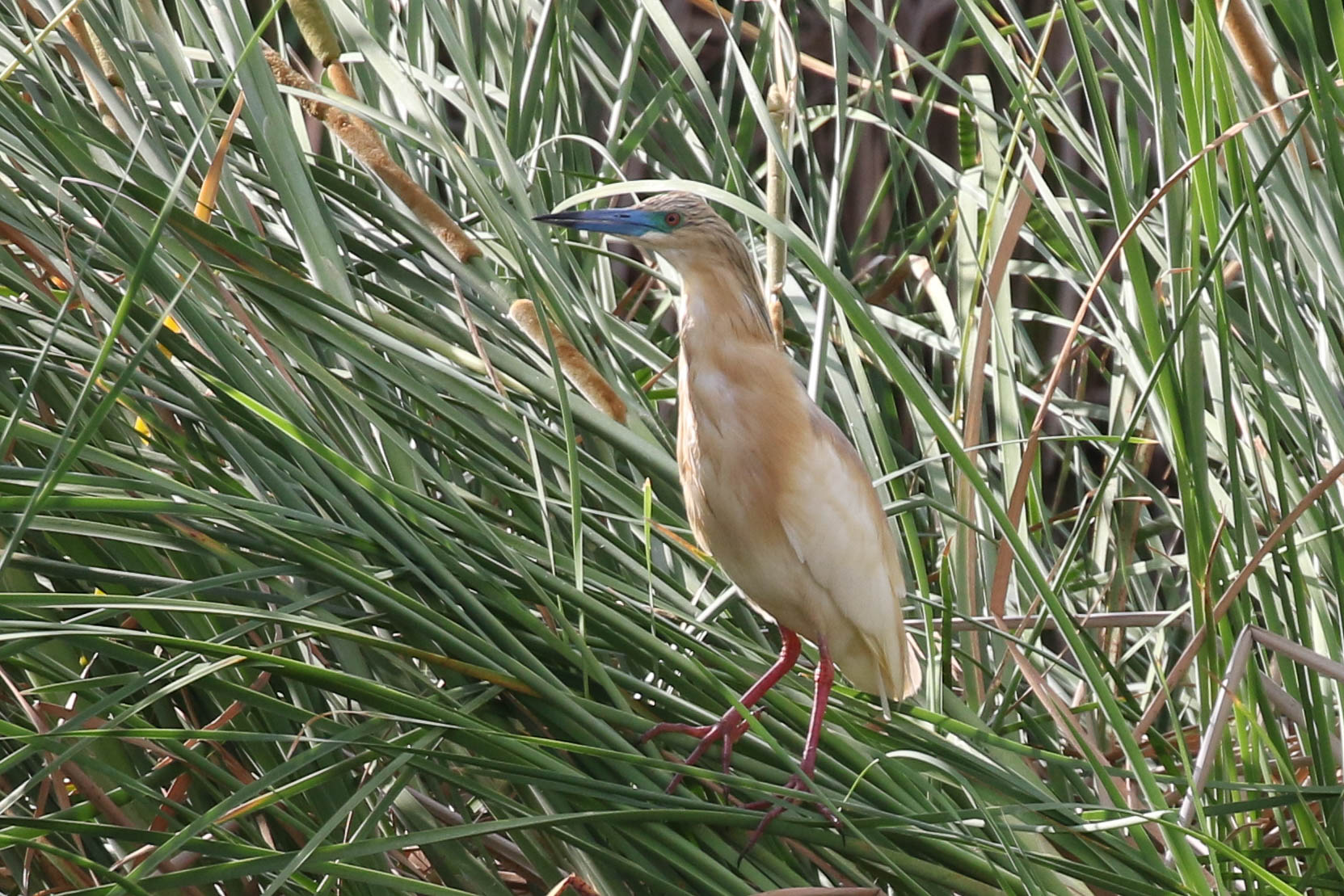
A Squacco Heron came up from the channel and landed on the edge of the sedges opposite, where it was then joined by a second. We could see several more herons along the edge of the water in front of hide – Purple Herons, Great White and Little Egrets. A Purple Swamphen emerged from the vegetation briefly, but swiftly walked back in; another called across the other side of the channel but remained out of view.
There were more Gull-billed Terns flying back and forth out over the water beyond the hide, and one occasionally came hawking up the channel straight past us, giving us great close views. We could hear a Great Reed Warbler singing from somewhere off in the reeds, and a couple of Reed Warblers were flitting about in the sedges below and back and forth across the water. A Zitting Cisticola was ‘zitting’ overhead and a Stonechat started singing from the top of a nearby bush. Scanning over the village behind us, we picked up a single Pallid Swift which showed off its browner colours as it flew back and forth in front of the old church.
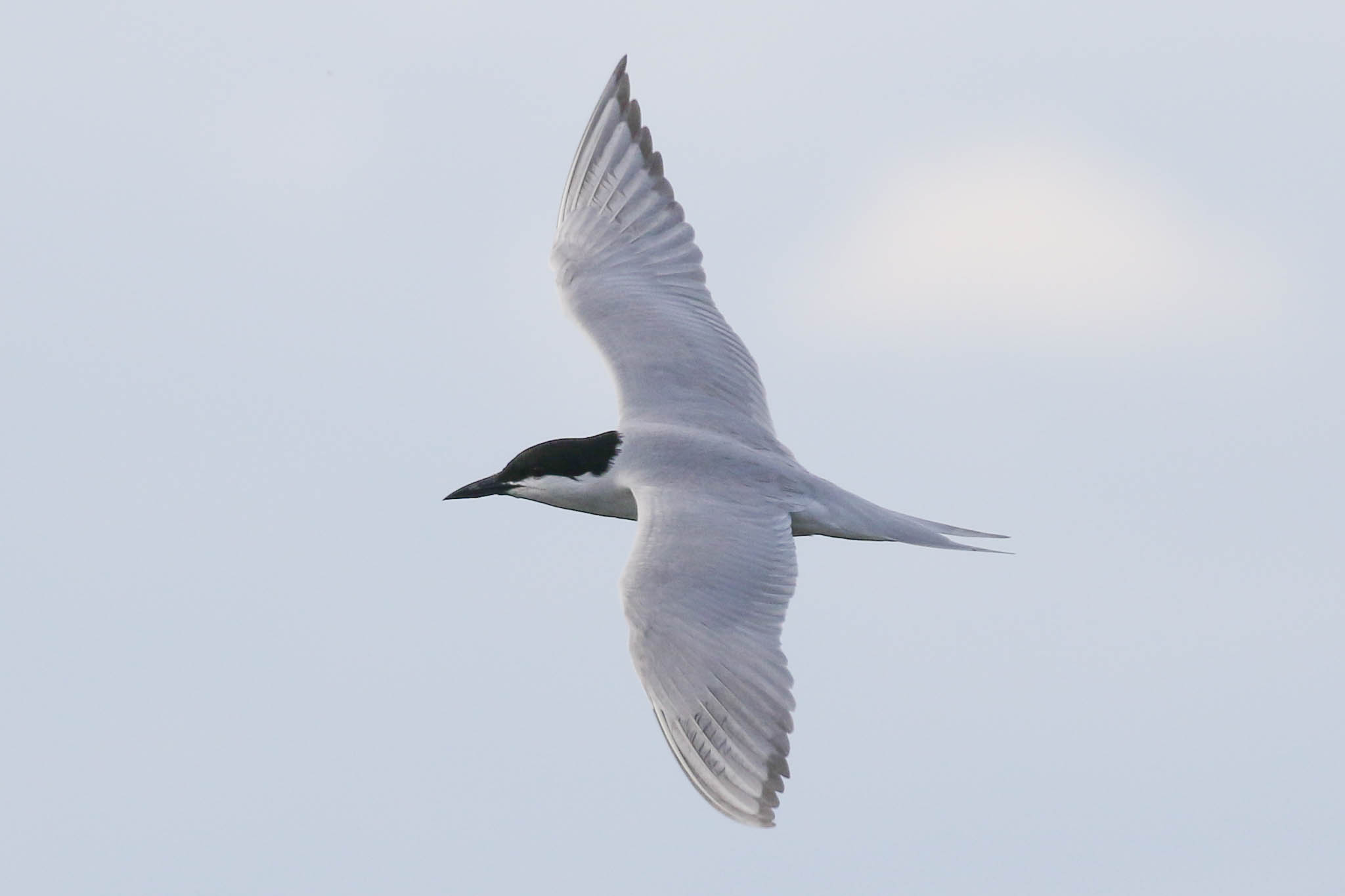
We walked a short way down the track towards Hide 2. Three Bee-eaters swept in calling and we had nice views in the scopes of an Iberian Grey Shrike on the wires. One of group picked up a large raptor very high in the sky, our first Black Vulture of the trip. There was too much to see and we still wanted to have a quick look for Black-winged Kite, so we turned around. As we walked back, a Little Bittern came up from the edge of the channel and landed in the sedges just across the water. A Nightingale was singing in the bushes opposite the car park.
As we drove round beyond the village, there were more Bee-eaters hawking low over the fields and one landed on a fence briefly. As we stopped to look, another Iberian Grey Shrike perched nicely on the top of the tree opposite. Continuing on, our first Iberian Magpie flew in and landed in a dead bush by the road briefly and we passed a Black-winged Stilt on a small pool.
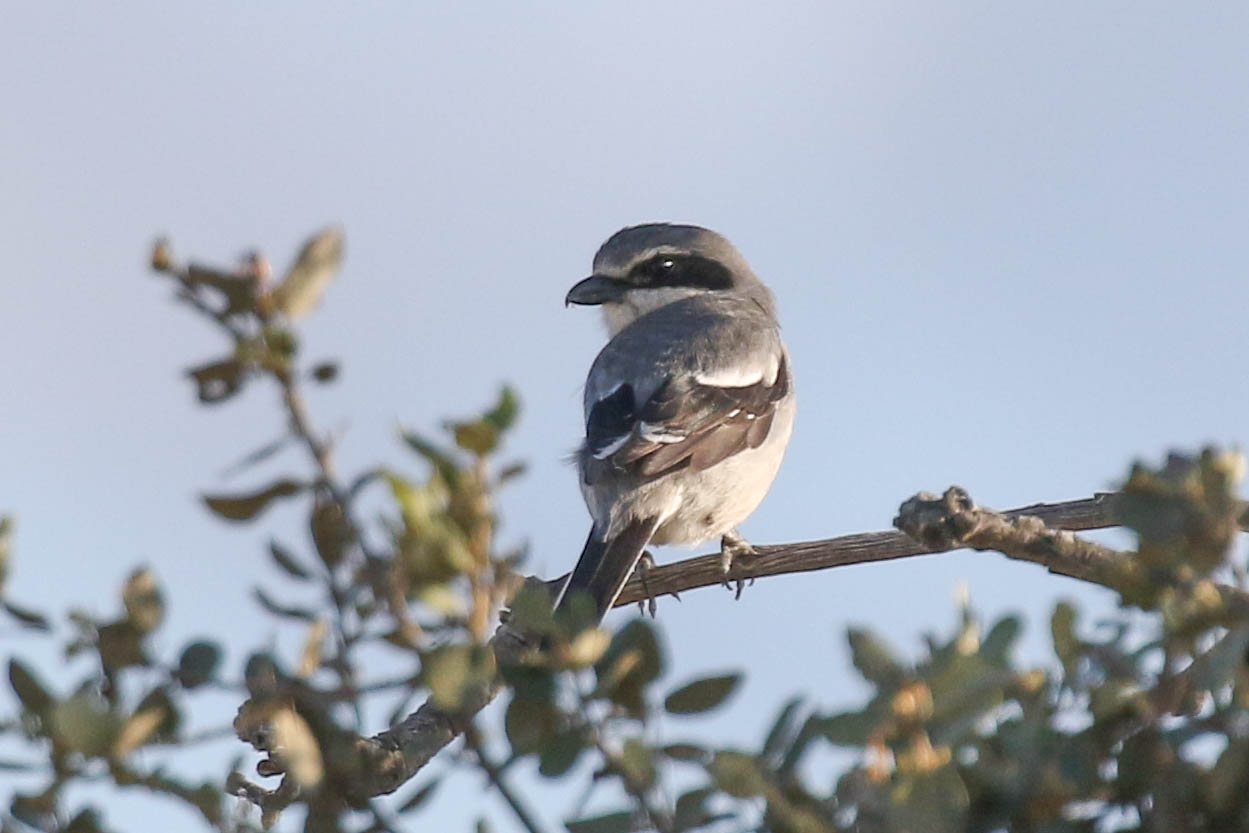
We stopped round the other side of the reservoir to scan the fields and watched as a Common Buzzard flew in and landed on stack of straw bales. Immediately, a Black-winged Kite appeared and started mobbing it, swooping at it repeatedly. Eventually the Buzzard flew off and the Black-winged Kite resumed hunting over the fields beyond. It was a great way to start the trip, but unfortunately we were out of time. It was a quick drive on to Pago de San Clemente, our base of the week, where after the various distractions of the journey we were slightly late now for dinner. Nevertheless, we received a warm welcome from our hosts, Martin & Claudia at El Recuerdo.
Monday 23rd May
It had been blisteringly hot a few days ago, but we were greeted by a cool start to our first day with low cloud hugging the hillside. There was a great selection of birds just around the gardens before breakfast – a gang of Iberian Magpies, a Sardinian Warbler, Hoopoe calling, Bee-eaters overhead, and a Nightingale singing which would provide a morning wake-up call for some of the group. After breakfast, as we set off down the road towards Trujillo, the low cloud turned into fog. Beyond the town, it looked like it might be starting to burn off so we continued on. After a quick stop for a Short-toed Eagle on a pylon by the road, we continued out onto the steppes, where the fog thankfully lifted to low cloud.
We parked and got out of the minibus. Several Black Kites were perched in a nearby tree, waiting for it to warm up. There were Corn Buntings and Crested Larks singing all around and Calandra Larks mostly further off over hillside beyond, though one flew in and landed just behind us at one point. A pair of Woodchat Shrikes chased each other round the cattle fences and three Hoopoes dropped out of the trees into the tall grass. Several Common Cuckoos flew back and forth overhead calling.

A bit further on, we turned onto the drovers track where another Woodchat Shrike posed nicely on the fence and several Bee-eaters swept back and forth over the fields. We stopped at the top of the rise and before we could even get out of the minibus, a flock of Pin-tailed Sandgrouse over calling. After a hasty exit, several more flocks or pairs came over in quick succession. We walked over to scan the field on the other side of the track and found a pair of Pin-tailed Sandgrouse and a pair of Black-bellied Sandgrouse feeding out on the short grass – a great start. There were more Calandra Larks here singing all around us – they are masters of mimicry, and the ones here seem to frequently include Green Sandpiper in their songs!

The cloud gradually started to break up, and the temperature started to warm up. The raptors quickly responded. Black Kites took to the air and circled up all around us and we picked up our first Spanish Imperial Eagle flying distantly out over the steppes, an adult with white shoulders and pale tail base. A bit later we picked up the same or another as it circled up a bit closer to us, at one point mobbed by a flock of about twenty Lesser Kestrels! When a cloud of Black Kites appeared over the ridge further up the track, we looked over to see a juvenile Spanish Imperial Eagle flying through the middle of them. Two Montagu’s Harriers quartered out over the grass, a Booted Eagle drifted over, and there were one or two Common Buzzards too. Raptor heaven!
We continued on and stopped to scan again. Standing on the edge of the track, the beautiful aroma of the wild lavender and thyme underfoot drifted upwards. There were lots of butterflies here around the wildflowers – Spanish Marbled White, Clouded Yellows, Meadow Browns. There were hundreds of Black Kites up now, in huge kettles scattered across the countryside in the distance. There were lots of vultures circling up too – at one point, two Black Vultures and a Griffon Vulture drifted overhead together, giving us a nice chance to compare the two. Another young Spanish Imperial Eagle circled high overhead. Lots of White Storks were feeding out in the grass. It was getting hot now, and activity on the plains was subsiding, so we decided to move on.
We stopped next by the bridge over the Rio Magasca. Several Crag Martins buzzed around with the Swallows and House Martins, and a Red-rumped Swallow flew round with them too briefly. A Kingfisher shot across over the water below us and a young White Wagtail was on the rocks, along with a few Spanish Terrapins. Several Serins and Greenfinches were feeding in the flowers on the river bank. From the bridge, a Melodious Warbler was singing in a tree just below us, and we had nice views in the scopes. A young Golden Eagle drifted away from us along the ridge beyond.

Driving on through the rocky steppes, a Griffon Vulture was standing in a field but flew off as we pulled up and we passed three different Short-toed Eagles on pylons by the road. We stopped again at the bridge over the Rio Almonte for lunch. Several Griffon Vultures soared up the river valley over the crags beyond and an Egyptian Vulture came up lower over the trees, circled up and carried on overhead. Another Red-rumped Swallow flew round over the river and more Crag Martins and several Spanish Sparrows were nesting under the bridge.
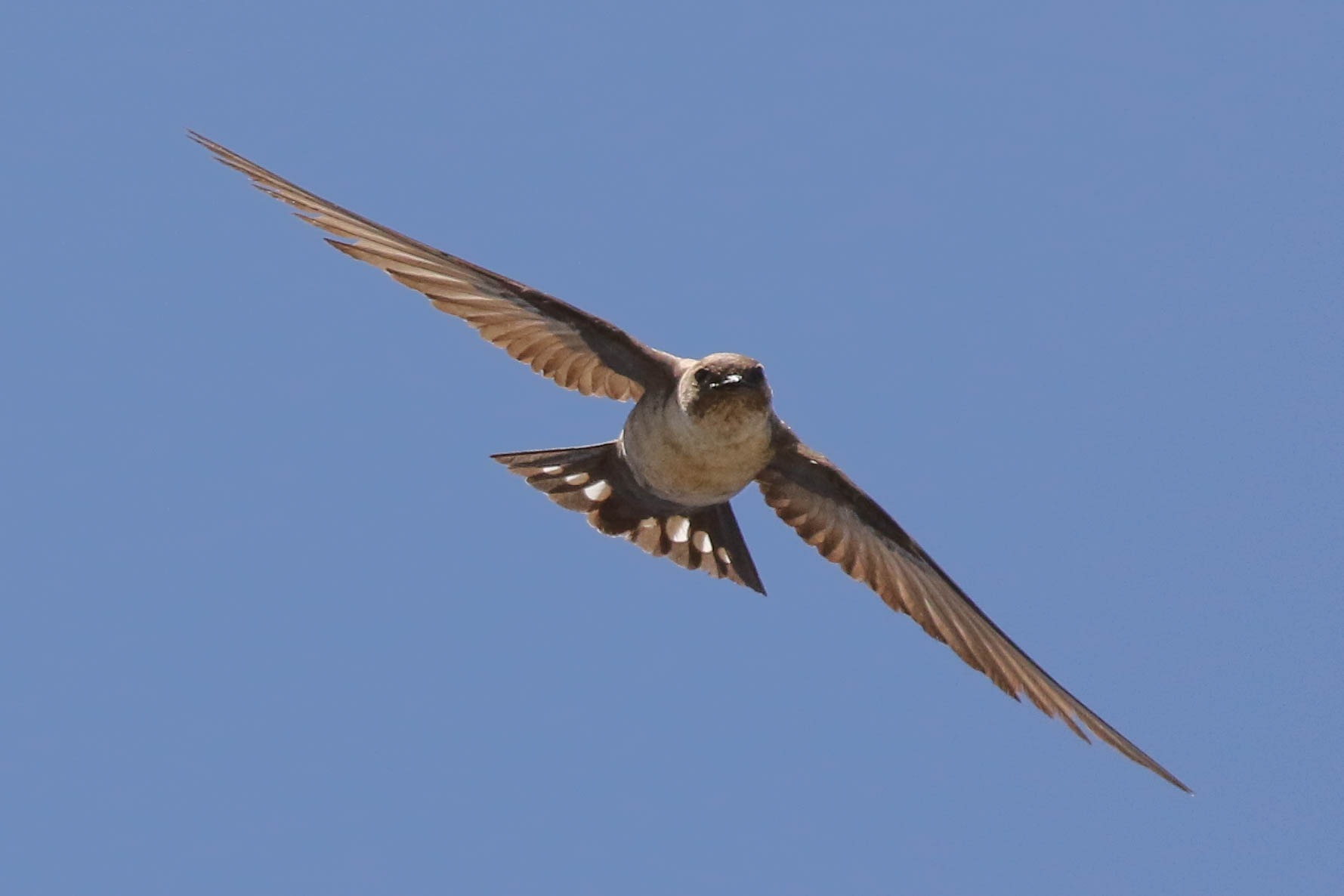
After lunch, we drove through Monroy and stopped under the stone pines where several White Storks were on their nests. We could hear them bill clapping as we set off down the track through the fields. The beautiful wildflowers on the sides of the path were alive with butterflies, including our first Southern Gatekeepers and Wall Browns, and we stopped to admire a couple of Mammoth Wasps feeding on the giant cardoon thistle heads. Several Iberian Magpies zipped in and out of the trees and a Hawfinch flew out of a holm oak and off across the path ahead of us.
We had nice views of a male Spanish Sparrow displaying to several females in some bushes by the track. A Hoopoe flew off through the olive trees and a Golden Oriole came out and shot off over the hillside behind us. A pair of Short-toed Eagles hung in the air high overhead, calling. There were lots of Corn Buntings and Crested Larks around the harvested fields and a pair of Woodchat Shrikes at the bottom of the hill, catching insects and taking them into the nearby trees presumably to feed their young. It was hot here now in the sunshine (though ‘just’ in the mid/high 20’s and not the 38-39C it had been last week!), so we walked back up the track to the minibus.
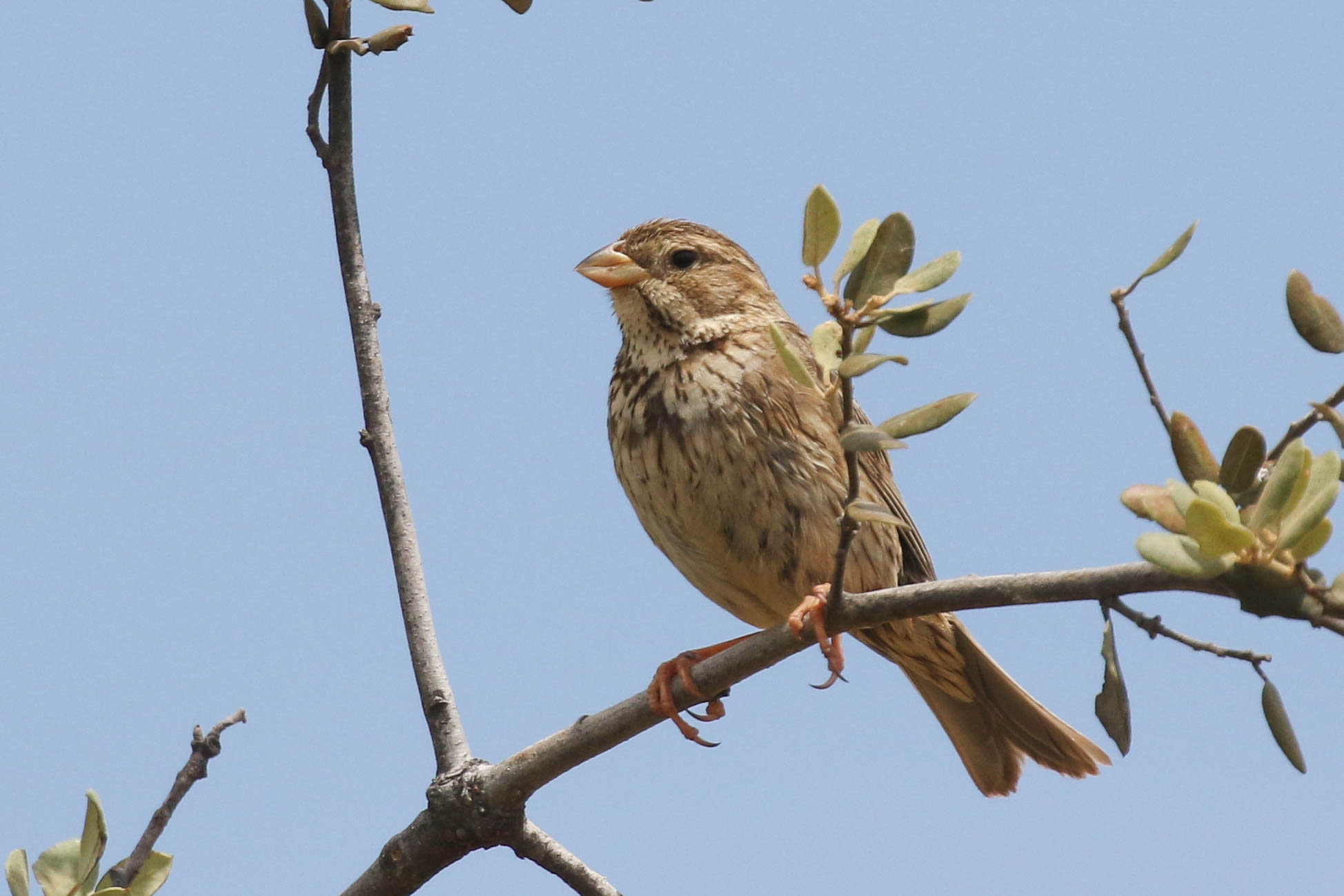
We drove down towards Caceres and stopped at another bridge over the Rio Almonte. Several Alpine Swifts zoomed back and forth overhead and we stood on the bridge to watch them taking nest material in underneath. A little further on, we started to see Roller boxes on the telegraph posts by the road and it wasn’t long before we spotted our first Roller on the wires. As there was nothing coming, we stopped to look. Just beyond, three Turtle Doves were on the wires too.
We stopped at a filling station the other side of Caceres to get a cold drink and afterwards drove back out onto the plains beyond. A Montpellier Snake in the road looked like it had unfortunately just been run over. Another Roller was on the wires here, so we stopped again for a closer look.

We turned onto a track and stopped by a gateway into the neighbouring fields. A Short-toed Lark flew across the road as we got out and we found several more out in the ploughed field in front, which we got in the scope. Two fluttered up overhead singing, so we could see the contrasting blackish underside to their tails. There was a Calandra Lark in the same field so we turned the scopes on that too. Looking across the other side of the road, we spotted two Great Bustards out in the grass distantly, our first of the trip. They kept completely disappearing in the vegetation – remarkable for such a large bird!
As we continued on along the track, the fields were alive with larks, Corn Buntings and Spanish Sparrows, and a large Ocellated Lizard at first refused to budge from in front of us. A female Montagu’s Harrier flew over the road ahead of us. It was time to head back, but we had one last stop again for the Great Bustards, which were a little closer from here. A couple of Rollers were on the wires and flying round over a small pool, which also held a Little Grebe and a few Gadwall.

As we drove back in to the village at Pago, a Ladder Snake was basking on the edge of the road, but disappeared into a hole in the wall as we pulled up. We had time to freshen up and go through the bird list for the day over a cold beer before a delicious local dinner of broad bean salad followed by empanadas.
Tuesday 24th May
It was a brighter start this morning. A Melodious Warbler was singing in the vegetation as we drove out of the village and we headed south towards Zorita. Our first destination this morning was Campo Lugar and as we turned onto the minor road, a Great Bustard flew across ahead of us. It landed out in the long grass so we stopped to look, a better view than yesterday, with less heat haze yet. One of the group then spotted a second Great Bustard, even closer. A Red-rumped Swallow flew past and a large flock of Cattle Egrets flew over heading towards the ricefields.
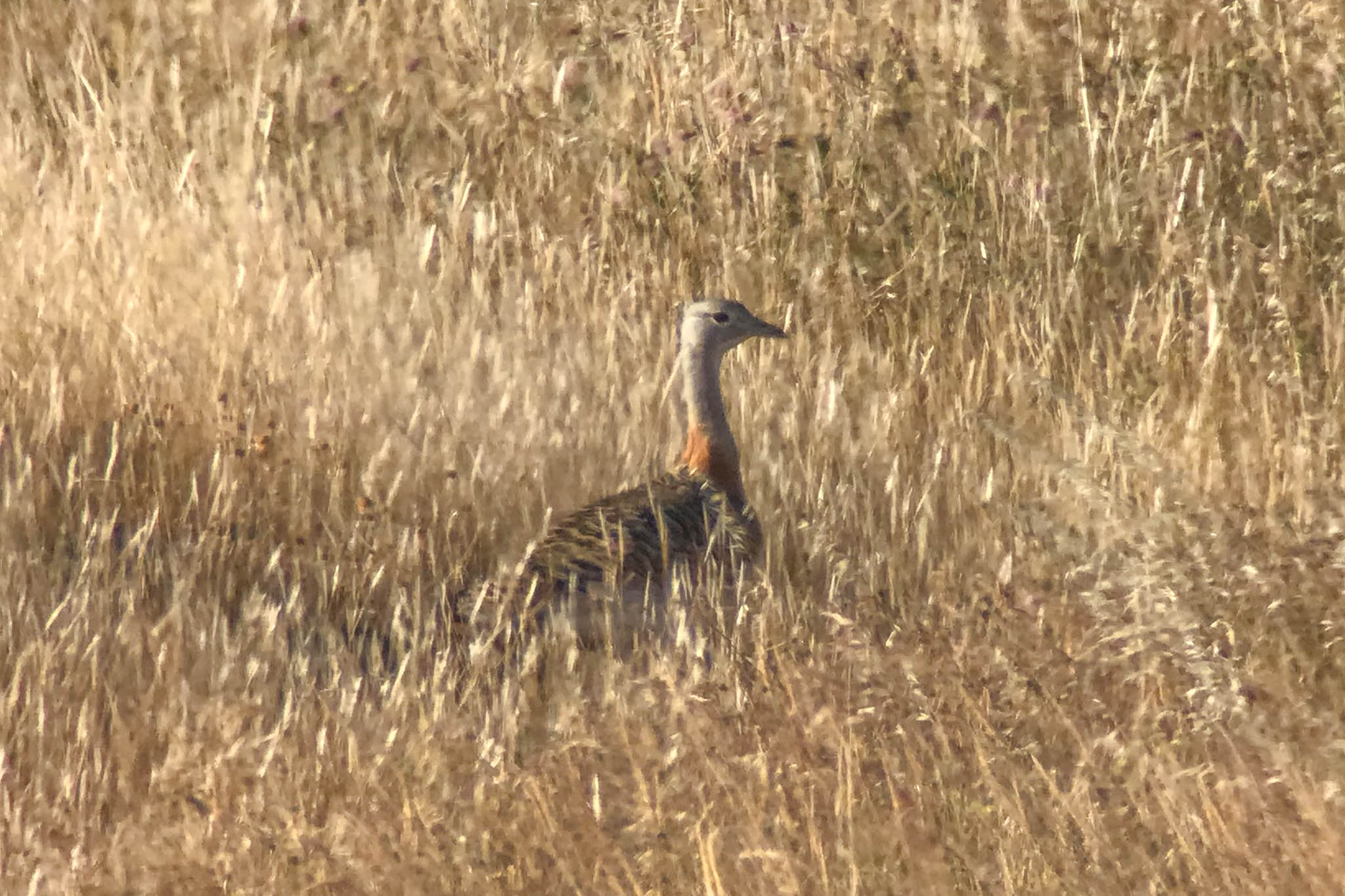
We continued on, stopping to scan from time to time. There were lots of Calandra Larks singing (more ‘Green Sandpipers’!), several Hoopoes feeding in the fields, and White Storks and Black Kites everywhere. We picked up another Great Bustard flying away in the distance. A juvenile Montagu’s Harrier came up from the fields down in the valley below and flew straight towards us, before banking away at last minute. When we stopped for a photo of the view, we picked up a Golden Eagle flying across the fields below, chased by another Montagu’s Harrier. It shook off its pursuer and as it started to circle up it was joined by another Golden Eagle, an immature this time. It was warming up, and lots of Griffon Vultures were spiralling up now.
A little further on, we could see a couple of Little Owls and Rollers on the nest boxes on the pylons, so we stopped again to look. Several Lesser Kestrels were hunting over the hillside here too, including a smart male which dropped into the grass to catch something in front of us. A Short-toed Eagle was perched on the pylon beyond. When you pull up in a gateway in the middle of nowhere of course a vehicle then appears and needs to turn in! The truck pulled up and the farmer asked what we were looking at. He offered to show us where the Little Bustard had been displaying, but despite taking us down to the field there was no sign – after the very hot weather last week, it seems like the males have stopped singing, the females may well be on eggs and the vegetation is very high now.
From Campo Lugar, we cut across to Alcollarin. We stopped to photograph some Bee-eaters on the fence by the road and could hear a Golden Oriole calling in the trees nearby. As we stopped by the dam, a Hoopoe flew across and landed on the wall on the top. A couple of Little Ringed Plovers were displaying down on the shore below us, and we could see lots of Great Crested Grebes and a couple of Little Grebes out on the water. There were lots of Cattle Egrets gathered on the bank of the reservoir in the distance further up and several Spoonbills in the water nest to them. Two Egyptian Geese were asleep on the opposite bank.

Further down the track, we stopped again for a closer look and picked up several Black-winged Stilts along the edge of the water. There was a nice selection of wildfowl on view from here now too, including a smart drake Garganey, a Shoveler, a large flock of Gadwall, plus a Greylag and a raft of Coot. A Purple Heron flew across low over the water. While we were scanning, a Great Spotted Cuckoo cut through our scope view, but it was unfortunately very distant and all but impossible for the rest of the group to get onto. A Red-rumped Swallow flew low overhead and a huge flock of Common Swifts was hawking over the hills behind – despite looking through, we couldn’t see anything else with them. A pair of Booted Eagles were displaying over the hills the other side of the reservour. A Quail was calling from somewhere out in the grass in front.
Down at the picnic area, a Woodchat Shrike was in the trees as we pulled up and a male Spanish Sparrow was displaying. Just beyond, a Kingfisher and a couple of White Wagtails were on the small dam, where we had to avoid stepping on a large Egyptian Grasshopper on the concrete in the viewing area. Scanning the small ‘reservoir’ here, we found two more Purple Herons and a family of Little Grebes, and watched a pair of Marsh Harriers doing a food pass. A Great Reed Warbler was singing in the distance, and then one started up much closer, in the reeds next to the start of the dam. When it flew out and up into a nearby holm oak, we could see it moving around in the leaves.
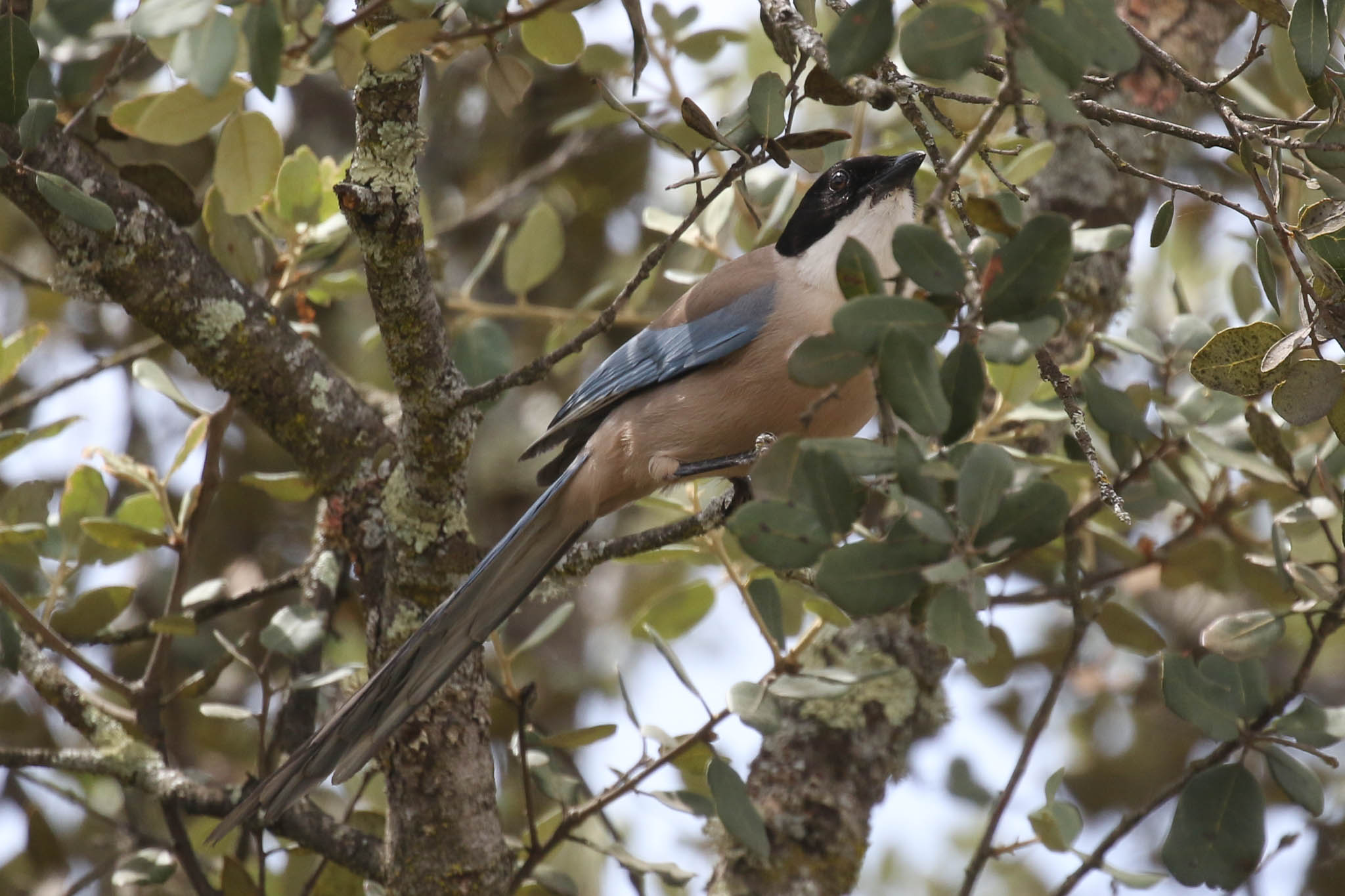
A large group of Iberian Magpies started alarm calling from the trees by the track behind the picnic area and when we walked over to see what was going on we could see a Booted Eagle on a branch below them. It flew out followed by cloud of the magpies! We stopped for lunch on the picnic tables, but the birding doesn’t end and we finally got better views of a Sardinian Warbler feeding low down in the bushes behind us while we ate.
After lunch, we cut back over Campo Lugar. It was quieter now, in the heat of day, but we did have a nice Short-toed Lark feeding in the road right in front of the minibus and a couple of Hoopoes collecting insects on the verge.

We drove in past the Santa Brava reservoir, where a family of Egyptian Geese was on the canal, and out into the ricefields beyond. We stopped to scan and heard Iberian Yellow Wagtails calling, distinctively ‘buzzier’ than our Yellow Wagtails, and eventually had good views of several perched in the cut rice stems out in the dry paddies.
A little further on, we stopped again to look at some muddy pools in a field and found a group of 22 Ringed Plover along with a single breeding-plumaged Dunlin and a lone Redshank – clearly there was still a trickle of northbound waders coming through. A Little Ringed Plover was displaying here too. A single Common Crane in one of the paddies off to the left with four White Storks was unexpected – there are thousands here in the winter, but not normally now, so presumably this bird was most likely sick or injured and unable to make the long journey back north.

Further on, we stopped again in a good area for Black-winged Kite. We had barely had a chance to get out of the minibus when one promptly flew past so we walked further up and found it perched in the top of a dead tree. It flew again and when we found what we thought was it, it was actually a second Black-winged Kite. While we were watching them both, a third then flew over and disappeared into a large holm oak – they had apparently nested here earlier in the year, so presumably this was the family party still together. We had some nice perched views of them in the scopes. A couple of striking Red-striped Oil Beetles caught our attention as they walked across the road, dodging the traffic, and a Quail called from somewhere in the grass.
Next we drove over to an area where Collared Pratincoles had been earlier in the year. As we parked by the start of a track it looked rather quiet initially but as we got out of the minibus, a Collared Pratincole flew in and dropped down into the back of the field next to us. It was followed by a second which flew in and landed closer to the road. We quickly got the scopes out and picked up the first Collared Pratincole straight away, even though it was very well camouflaged against the brown clumps of earth in amongst the aubergine seedlings. We couldn’t see the second from here, but as we drove off we found it again looking back down into the field from the minibus. Nice views!
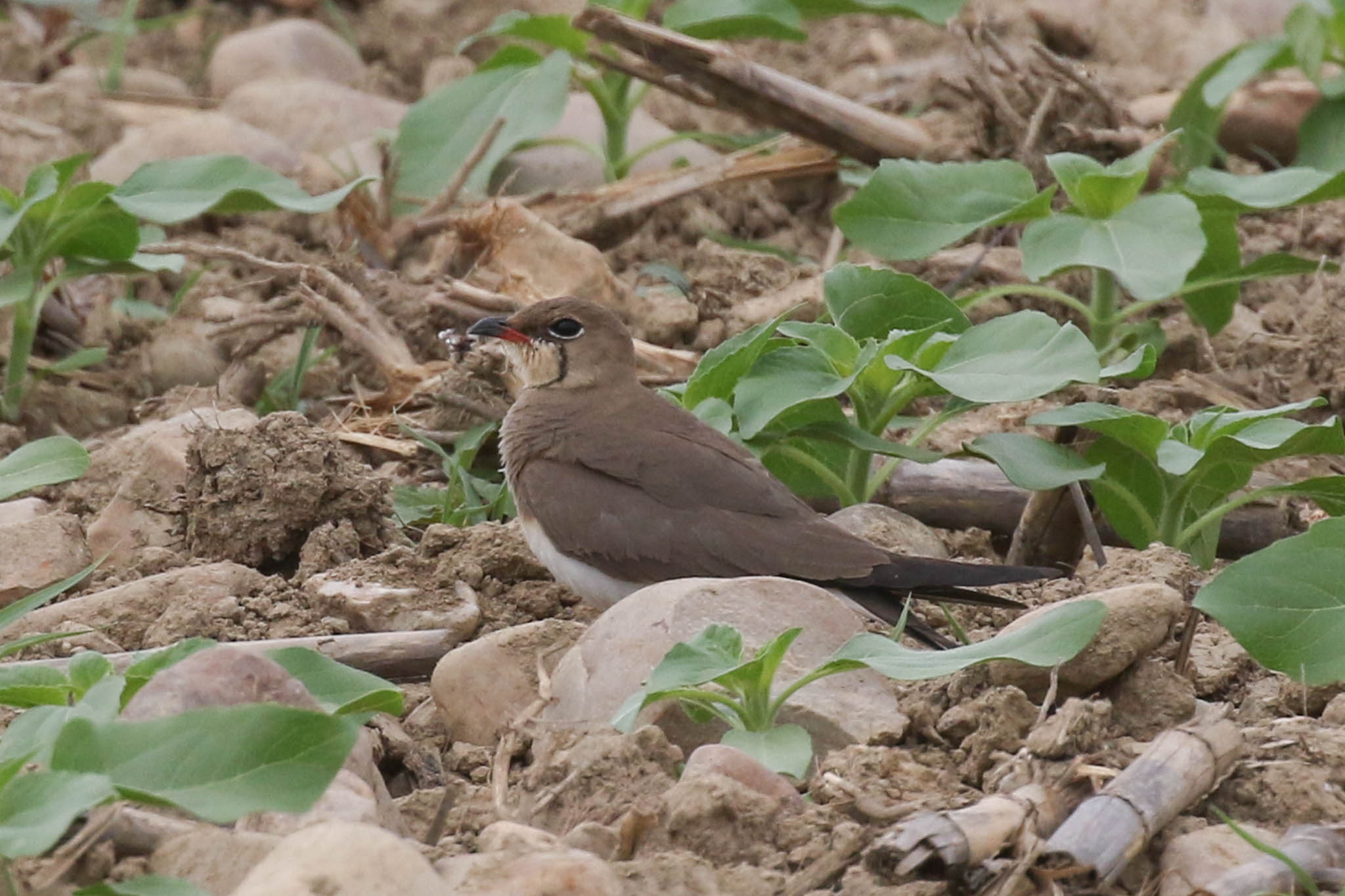
We stopped in Madrigalejo for to use the facilities and get a cold drink. We still had a little bit of time before we had to get back, so we thought we could have a quick look at Moheda Alta, but as we walked up onto the bank of the reservoir, we could immediately see there was too much water and just a few Great Crested Grebes here now. We were hoping to come across some waxbills or avadavats, but the wind had picked up into the afternoon and everything was keeping down now. As we cut back through Vegas Altas, a couple of Common Waxbills flew off ahead of us but disappeared before they could be seen by the group.
Back out onto the main road, a male Montagu’s Harrier was hunting low over the fields and then a female appeared too. They disappeared round behind us and appeared to land, but it is a busy road and there was nowhere to stop. We drove on and turned round and as we came back past we were able to stop at the entrance to a nearby track. We had great views of the pair of Montagu’s Harriers now – the male flew in and landed again, bring up two Iberian Yellow Wagtails which came over to mob it.

On our way back, we had a quick stop in Madrigalejo by the canal. There were loads of hirundines hawking over the water and a Kingfisher perched on a small post. A bright lemon yellow male Serin was in a tree with sparrows on the far bank. When it flew past us on the bridge and landed the other side, there were at least five Serins together now, including several smart males. Then it really was time to head back for dinner.
Wednesday 25th May
We were heading for the national park at Monfrague today, but on our way first thing we drove round via Belen. Out of the village, we stopped to scan and found a Thekla Lark singing on the rocks in the field nest to us. Out on the plains, we could hear Calandra Larks all around again. When a Great Bustard flew over the road ahead of us, we stopped and got out and found two more distantly in the long grass on a ridge.
Further on, scanning the grass we picked up a Stone Curlew around group of rocks, so we stopped again. A second Stone Curlew was close nearby and a female Montagu’s Harrier landed on a rock to eat whatever it had just caught. Setting off again, a Great Spotted Cuckoo came up from the side of road and landed on the fence a bit further up. This one was much easier to see than yesterday’s and we all had great views of it using the minibus as a hide.
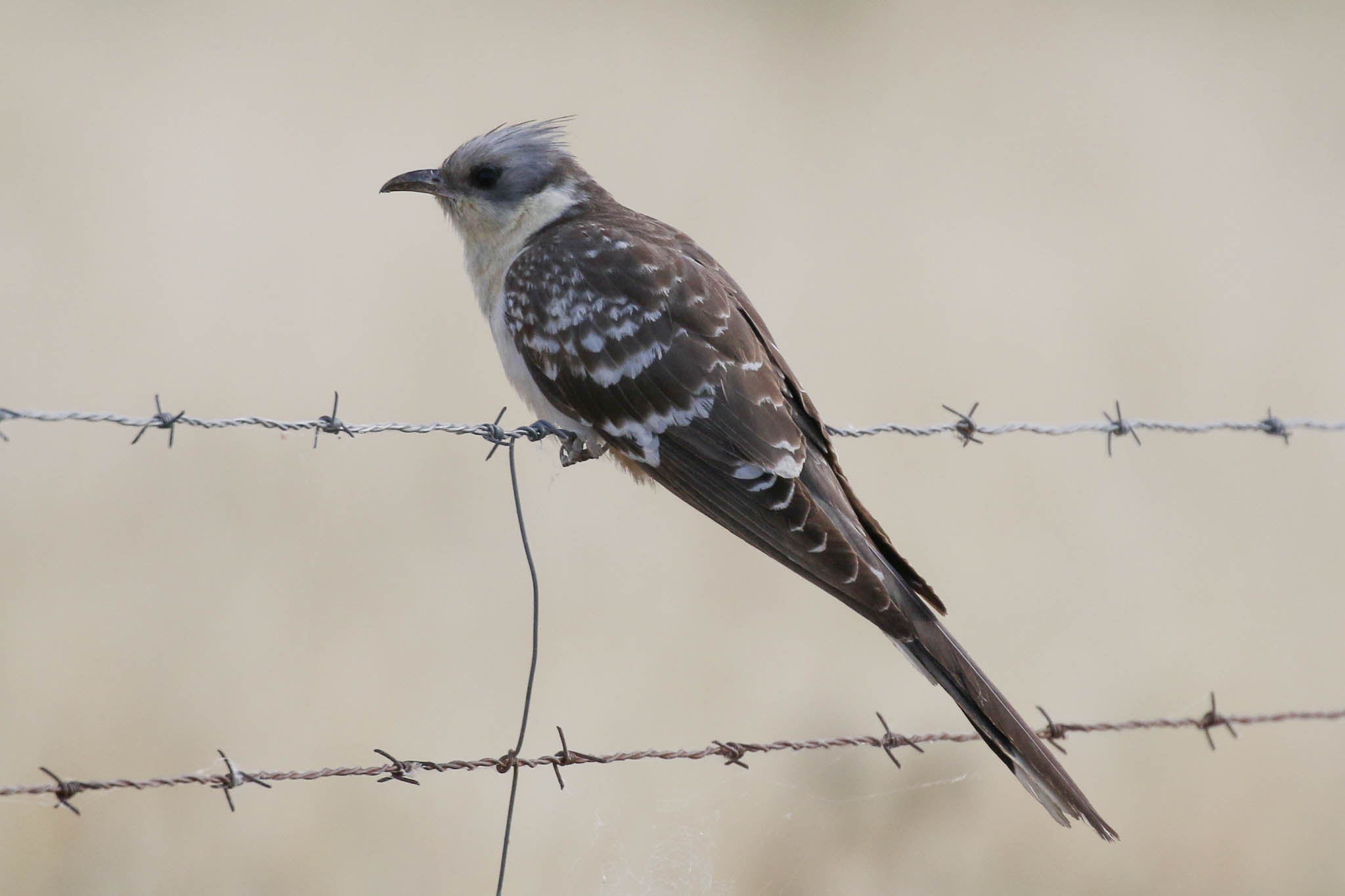
At the end of the plains, we cut across to the Torrejon road, stopping on the way briefly to watch two Black Vultures circling up low over the dehesa with a single Griffon. As we came into the park at Monfrague, a Robin flicked up from the side of the road and a Eurasian Jay flew across ahead of us, both additions to the trip list. It was already mid-morning so we made our way straight up to the Castillo. As we walked up to the steps, there were lots of Great Tits under the trees, a family of Black Redstarts feeding around the rocks, and a Hawfinch flew across the path ahead of us. Up the steps to the castle, one or two Griffons were circling at eye level now. Out onto the watchpoint, we stood and admired the fantastic views over the countryside all around.
There were lots of Griffons over the Peña Falcon, and a few Black Vultures and one or two Egyptian Vultures with them. From time to time one or two would drift over our side and circle up over the trees or past us along ridge – great to watch! A Black Redstart was singing from the top of the Castillo, a couple of Sardinian Warblers were in the trees below, a Great Spotted Woodpecker called and we had a tantalizing glimpse of our first Blue Rock Thrush as it flew past (not to worry, we would see lots very shortly!). There were lots of hirundines, including Crag Martins and one or two Red-rumped Swallows, swirling around but no swifts along the ridge now, possibly as there was no wind today. Just as we started to walk back down, a small flock of Common Swift came in briefly, but there was nothing with them.
Back at the minibus, a Short-toed Treecreeper was singing and we watched it in the trees. We drove back down and round to Salto del Gitano next. As we parked, a Blue Rock Thrush was singing from high on the crag behind, so we got it in the scope. We could hear a Rock Bunting singing somewhere high up too, and eventually it dropped down and landed on a rock where we could see it. There were lots of Griffons circling overhead and several perched on the rocks below us – fantastic views. One landed on the small peak just above us, looking down at us as if to see if anyone was dead yet! A Peregrine flew out from the top of the crags opposite with something in its talons and over the river.

Scanning the cliffs, we found a Black Stork nest, the adult with its back to us sheltering several downy young from the sun. A second Black Stork flew in and landed on a rock nearby, giving much better views in the scope.

There were lots of Blue Rock Thrushes now, they seemed to be everywhere – we had a great view of a young male with a brown throat and a smart all-blue adult male posed on the rocks just below us. A Turtle Dove was purring in the trees and several Crag Martins zoomed round.
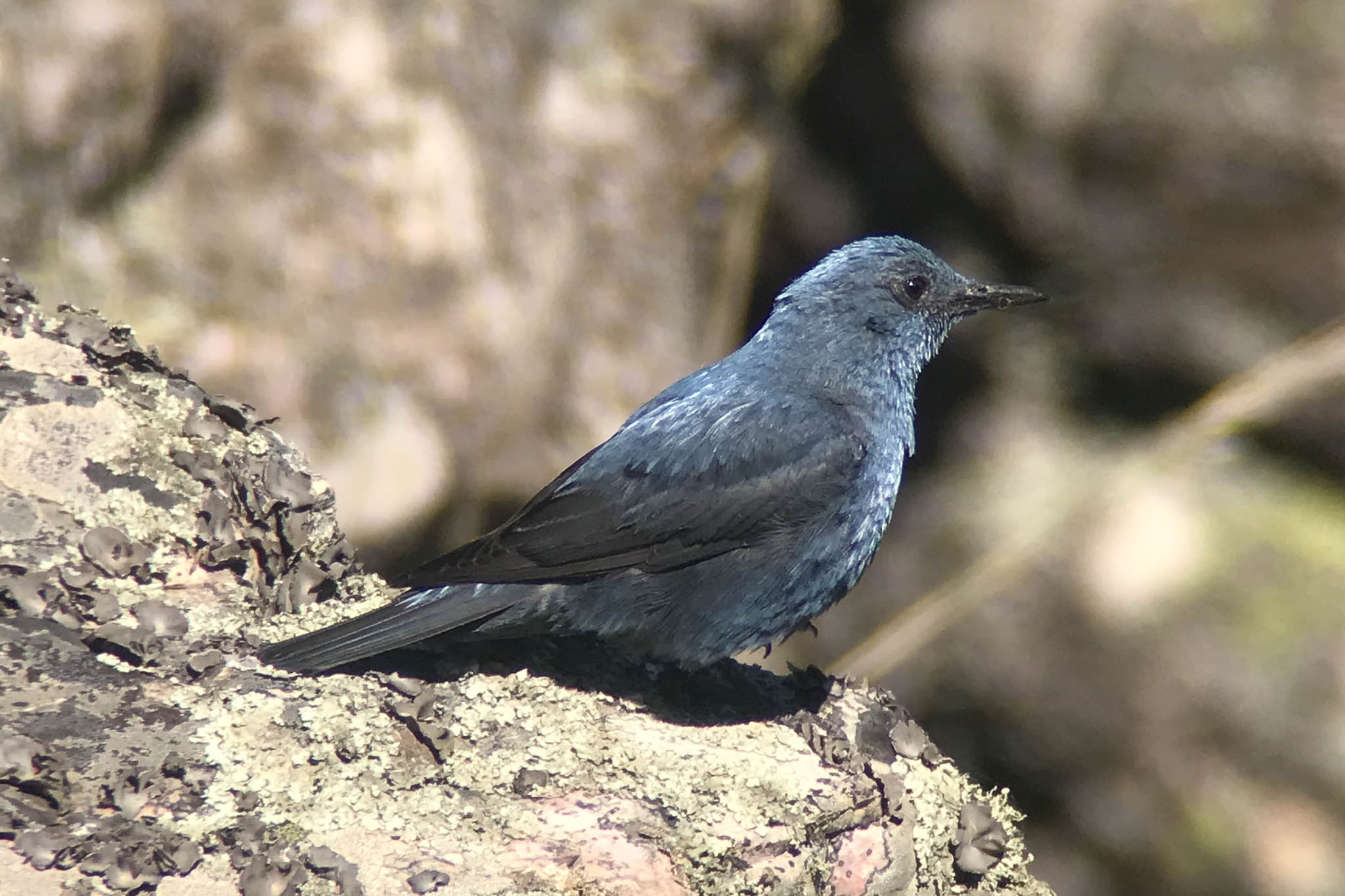
There was so much to see, we could have stayed here all day, but we had to tear ourselves away. Two Alpine Swifts were over the Tajo bridge as we passed by, on our way up to Villareal for lunch. At the picnic tables, we were watching a couple of Spotless Starlings on the building behind when a Golden Oriole flicked across in the trees beyond. We could see now there were several mulberry trees dripping in fruit and they were full of birds. There were lots of Hawfinches, including a family party with two spotty juveniles.
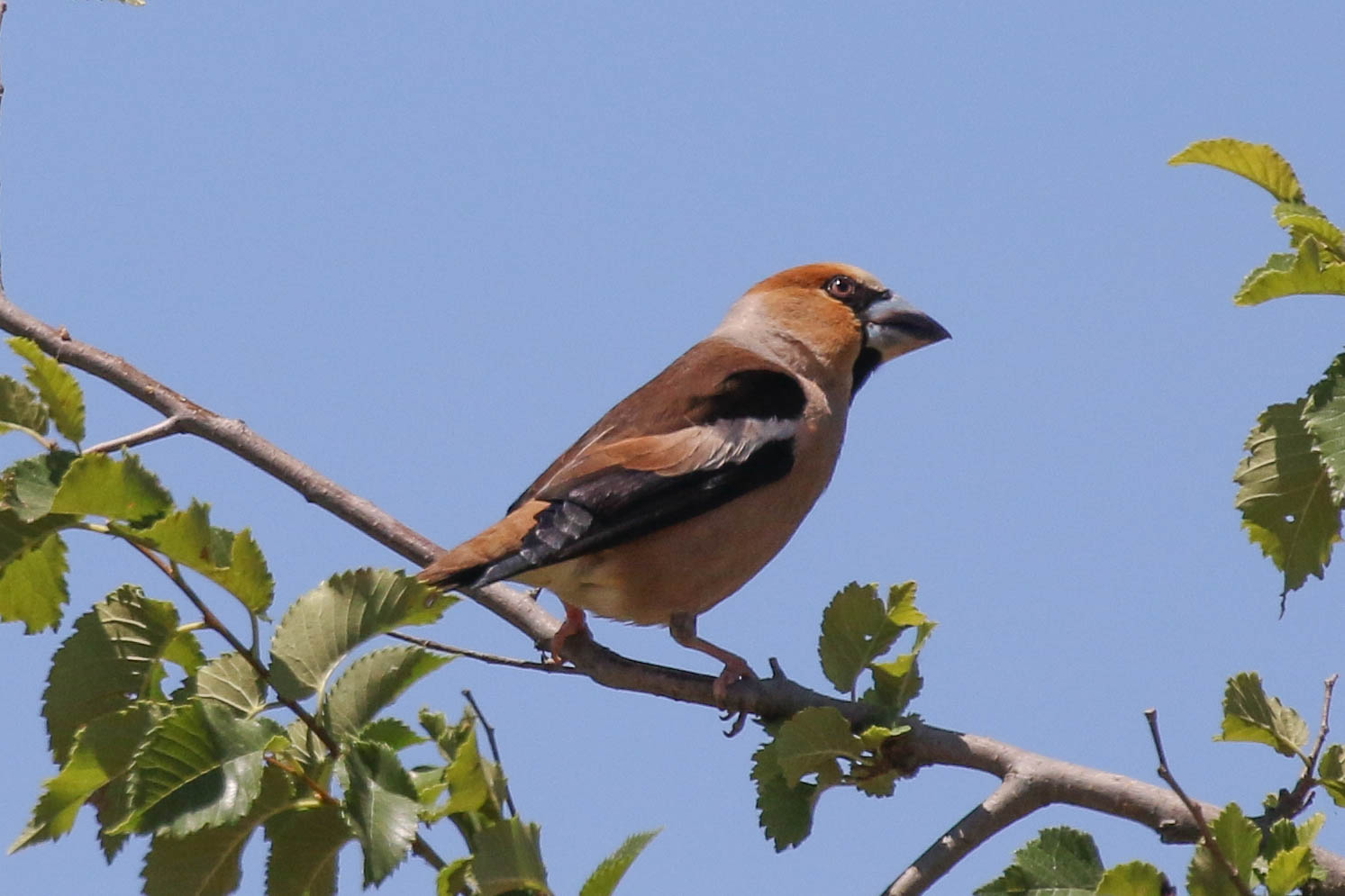
As we walked round the back, two Golden Orioles flew out and down into the trees towards the road where we could hear them fluting. After lunch, we walked round again, and several Golden Orioles flew out this time. One landed in a small fenced-off group of trees in the car park – we had nice views of it perched briefly, before it flew, a bright golden yellow male, it looked stunning as it caught the sun. Two more Golden Orioles flew back round behind us, greener female types they landed in the mulberries but were impossible to see in the trees, before flying off out again. Stunning birds!
Back to the minibus, we carried on through the park. The Mirador La Tajadilla looked fairly unpromising at first, quiet in the heat of the day. A couple of Little Ringed Plovers were down on the river below and a Red Deer briefly across the river. But checking round the trees, we heard a Western Subalpine Warbler singing just across the road and found two feeding in the bushes together, low down on the verge, which showed really well for the group. As we walked back to the minibus, a stunning Two-tailed Pasha butterfly flew past.

We stopped again further along at the Mirador de la Higuerilla, admiring the great view, looking down at the Tietar river, as another Turtle Dove purred in the trees and a Black Kite drifted past just below us.
Our last stop was at the Portilla del Tietar. Another Two-tailed Pasha flew past as we got out of the minibus and lots of Spanish Purple Hairstreaks were feeding on the fennel flowers under the trees down at the viewpoint. Several Griffons were circling over the rocks opposite and more were perched on the cliffs, and an Egyptian Vulture circled round and landed. A distant Black Stork circled up with vultures over the hillside beyond.
Despite the mid-afternoon heat, there were Nightingales singing and Turtle Doves purring in the bushes, a Short-toed Treecreeper and a Long-tailed Tit briefly in the trees by the hide, and a Blue Rock Thrush on the crag just behind. A Rock Bunting flew in and started singing in the tree right above us.
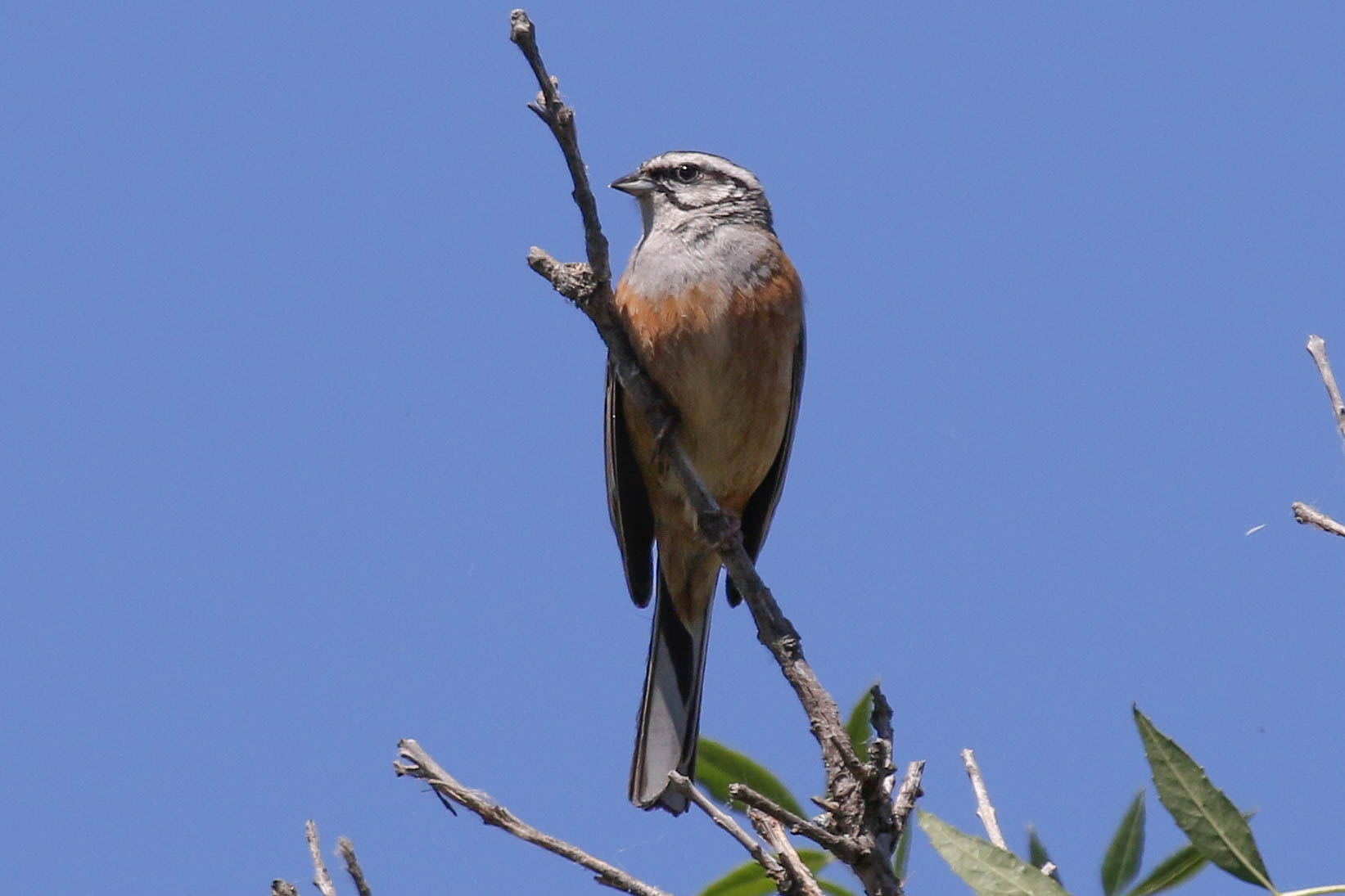
It was time to head back. On the way, a smart male Western Black-eared Wheatear flicked up from the side of the road, perching briefly in a cistus bush next to the minibus before flying again and landing on a road sign ahead of us. We had a quick stop in Villareal for a cold drink and could still hear Golden Orioles fluting in the distance, but the mulberry trees were much quieter now. A quick look at Arroyo de la Vid produced only a Sardinian Warbler in the bushes.
After dinner and a rest, we had a short walk up behind the village at dusk. There had apparently been Red-necked Nightjar seen here recently, but despite staying until it got dark there was no sign tonight. We would have to try further afield another night.
Thursday 26th May
After breakfast, we set off on the long drive down to the plains of La Serena. Cutting across along the road from Campanario, a Little Owl was perched on a nearby fence and a Great Spotted Cuckoo flew up the hillside from the road. There were lots of Black Kites perched on the rocky pinnacles. It was going to be a hotter day today and despite still being quite early it was already up to 21C.
Driving out across the plains, it was rather quiet at first. We stopped to look at two Great Bustards in a field and found two more distantly in the grass behind. A little further on, a Montagu’s Harrier was hunting beside the road and two Pin-tailed Sandgrouse flew up and over the road. We could see lots of vultures circling up over the plains ahead and when we got closer and pulled into a field entrance we found a massive feeding frenzy out on the grass. There were lots of Griffons and a couple of Black Vultures in a large mob, lots of squabbling, we could see their bloody red heads. Quite a spectacle!
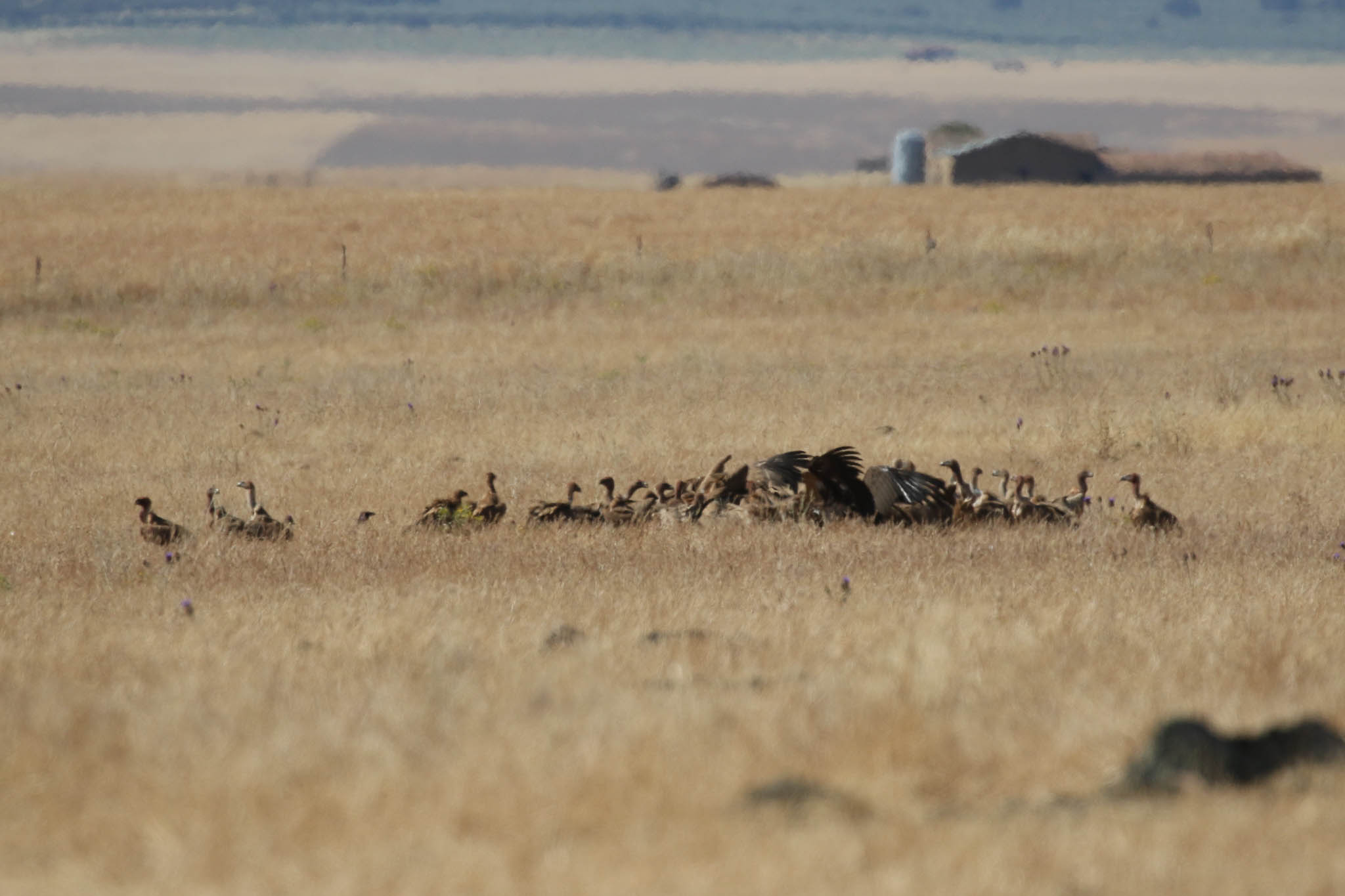
A shepherd was herding the sheep across the field opposite on a motorbike and flushed two more Pin-tailed Sandgrouse which flew off past us. He wanted to bring the sheep across the road and in through the gateway where we had parked – it was a good time to move on! There were large flocks of sparrows in the fields by the road further south, but not much else.
We decided to head into the hills beyond and drove round to Benquerencia. After wrestling with the narrow streets and some random Spanish roadworks, we found somewhere to park and took the path up to the Castillo. A Blue Rock Thrush was singing on the crags above us and one of the group had a Black Redstart too. Scanning the rocks, we quickly found our main target here – a female Black Wheatear gave us the runaround a bit at first, then a male Black Wheatear appeared nearby too, and we eventually had good views through the scopes of them when they settled down.
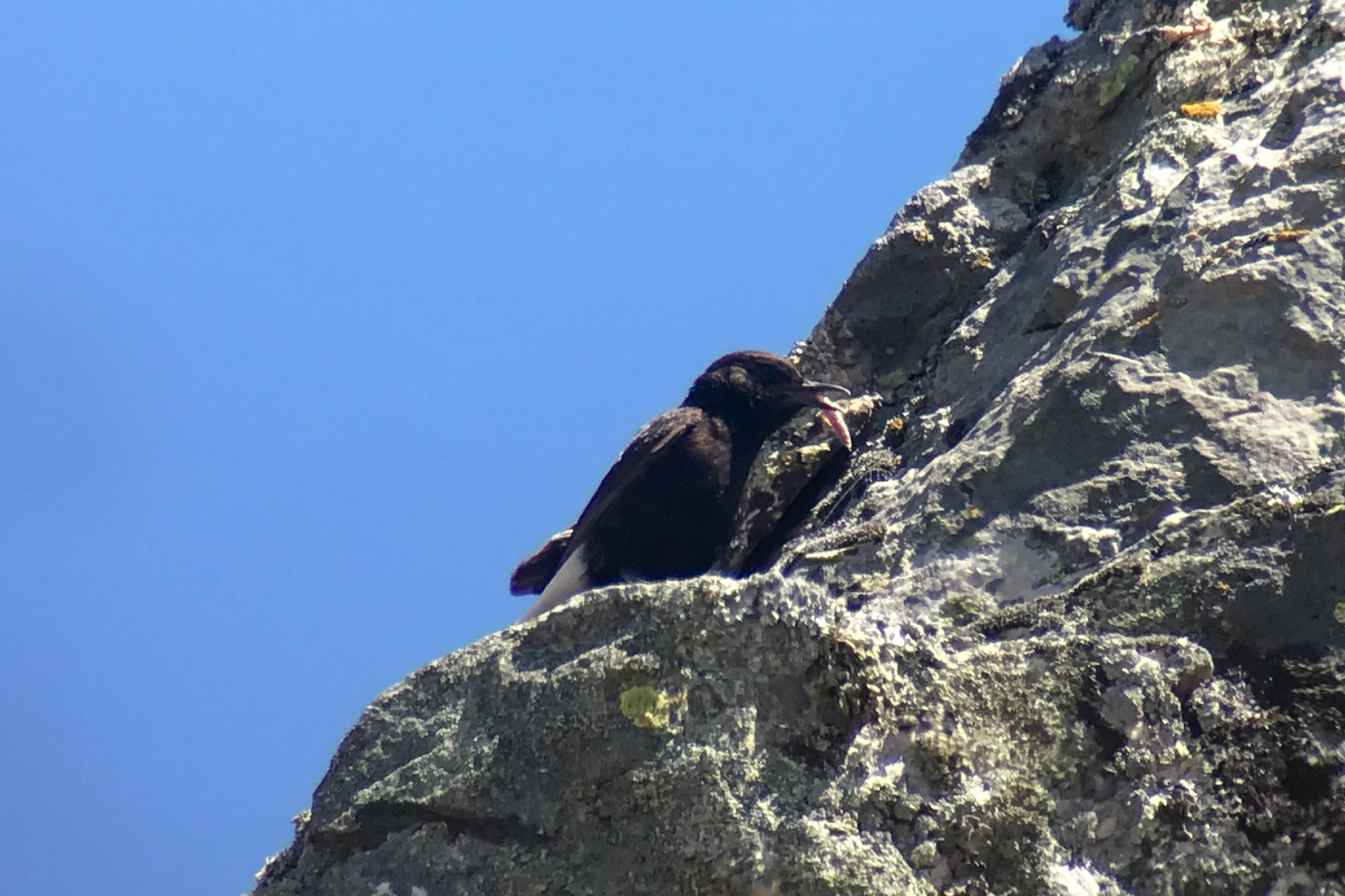
Further up, a Thekla Lark was singing and a Rock Bunting was calling quietly with a bill full of food, presumably waiting for us to move on so it could feed a hungry brood nearby. The sky was alive with activity – there were the usual Crag Martins and Red-rumped Swallows swooping around the cliffs, several Alpine Swifts zoomed past around the rocks and three Red-billed Choughs flew off along the ridge calling. As we climbed up onto the castle, there were insects too, lots of Southern Marbled Skipper butterflies fluttering around and red and black Firebugs in the low vegetation. Several Lesser Kestrels came up off the brickwork and circled over the hillside beyond as we climbed up to the top, from where we had a great view out across the plains, with the birds all flying past below.
We made our way back down and stopped for lunch at the minibus. Afterwards, driving back north, a Red Kite flew over the road with the Black Kites and three Montagu’s Harriers were in the fields. Our next stop was at the viewpoint at Puerto Peña. There were lots of Griffons up over the cliffs and two Black Storks drifted over high as we arrived; later another stork circled low over the rocks before landing briefly on cliffs. We could hear Golden Orioles fluting from the valley below and a Two-tailed Pasha fluttered around the bushes in the car park, but once again was typically flighty and despite threatening to at one point it just wouldn’t settle.
There were more Alpine Swifts here but they were very high over the crags and not as good views as we had already enjoyed, along with lots of hirundines. When we caught sight of a flock of Common Swifts high in the sky behind us, we were just checking through when we picked up two raptors beyond. They were very high and very distant, but as they drifted in we could see they were two Bonelli’s Eagles. When they folded their wings back and started to drop, we thought they might come in to the cliffs but instead they disappeared round behind the crags, still a long way off. We stayed for a while hoping they might come in again, but there was no further sign.
We had one last stop we wanted to make today in the Sierra de Villuercas. As we parked in a steep valley and got out to scan the rocks, there didn’t seem to be many swifts at first, just a few much further up the valley looking into the sun. Then three swifts appeared down the valley – two Common Swifts and a single White-rumped Swift with them. It was a rather distant view at first, before they disappeared round behind some rocks, then the White-rumped Swift reappeared on its own. It gradually came closer before turning and coming right over our heads. We could see its white rump as it turned, and the white trailing edge to its secondaries. In Europe, they can only be seen in southern Spain in the summer and are late to return here, so can only be found on visits from mid-May onwards. A real speciality of the area!

Two Egyptian Vultures and a distant Booted Eagle circled up. A male Golden Oriole flew up the valley and disappeared up through the rocks on the other side. We walked down to the river, where a Cetti’s Warbler and Blackcap were singing in the trees and a pair of Beautiful Demoiselle damselflies were down by the water. The White-rumped Swift drifted back up the valley, over our heads again. A good way to end the day – our target here achieved, it was time to head back again.
Friday 27th May
We got up before dawn and set out for a pre-breakfast visit to the Santa Marta steppes today. As we parked out on the drovers track and scanned the steppes, a Great Bustard flew in and landed up on the ridge, strutting across before disappearing over the top. A Red Fox was up on the ridge too. Several Pin-tailed Sandgrouse were calling and flying round in small groups, a distant Spanish Imperial Eagle was perched on the top of a tree and once again the air was filled with the sound of all the Calandra Larks singing.

A bit further up, we stopped again and found lots of sandgrouse on the ground from here, at least 14 Pin-tailed Sandgrouse and pair of Black-bellied Sandgrouse. We picked up a Stone Curlew out in the short grass too, and a Little Owl on a distant barn roof. On further and we stopped a third time. We were further away but it was great light looking down on the sandgrouse from here and we had a better view of the Spanish Imperial Eagle. We were hoping we might get lucky and find a Little Bustard, but we were out of luck – they seemed to have stopped displaying. Still, it was great to be out on the steppes at dawn, watching the sunrise. Now it was time to head back for breakfast.
After breakfast, we set off on the long drive down to Merida. We headed out into a vast area of orchards and vineyards first and as we parked and got out, we could hear Crested Larks singing in the fields. We were looking for Rufous-tailed Scrub Robin (aka Rufous Bush Chat, Rufous Bush Robin, etc) and as we walked slowly along the track we heard one sing briefly further up. As we stopped to look, we heard something else singing and realized it was a Western Orphean Warbler in a nearby olive tree. Not what we were expecting to see here, but we had a nice view in the scope.

We couldn’t hear the robin now, and it was already starting to get hot, so we decided to have a quick drive round to see if we could find another one singing elsewhere. We tried down another track on the other side of road and it all seemed very quiet, just one Woodchat Shrike which flew out of an olive tree when we got out to listen. We turned round to come back and as we drove along we heard a Rufous-tailed Scrub Robin through the open window of the minibus sing briefly. As we pulled up, it flew out of the olive grove next to us and round behind us. We got out and heard it singing from another olive tree on the other side of the road. We got the scopes on it and had a great view of it perched in the leaves in the top of the tree. Another bird which returns late in the spring, this is another species which you can only find from mid-May and the western race is restricted in Europe to southern Spain.
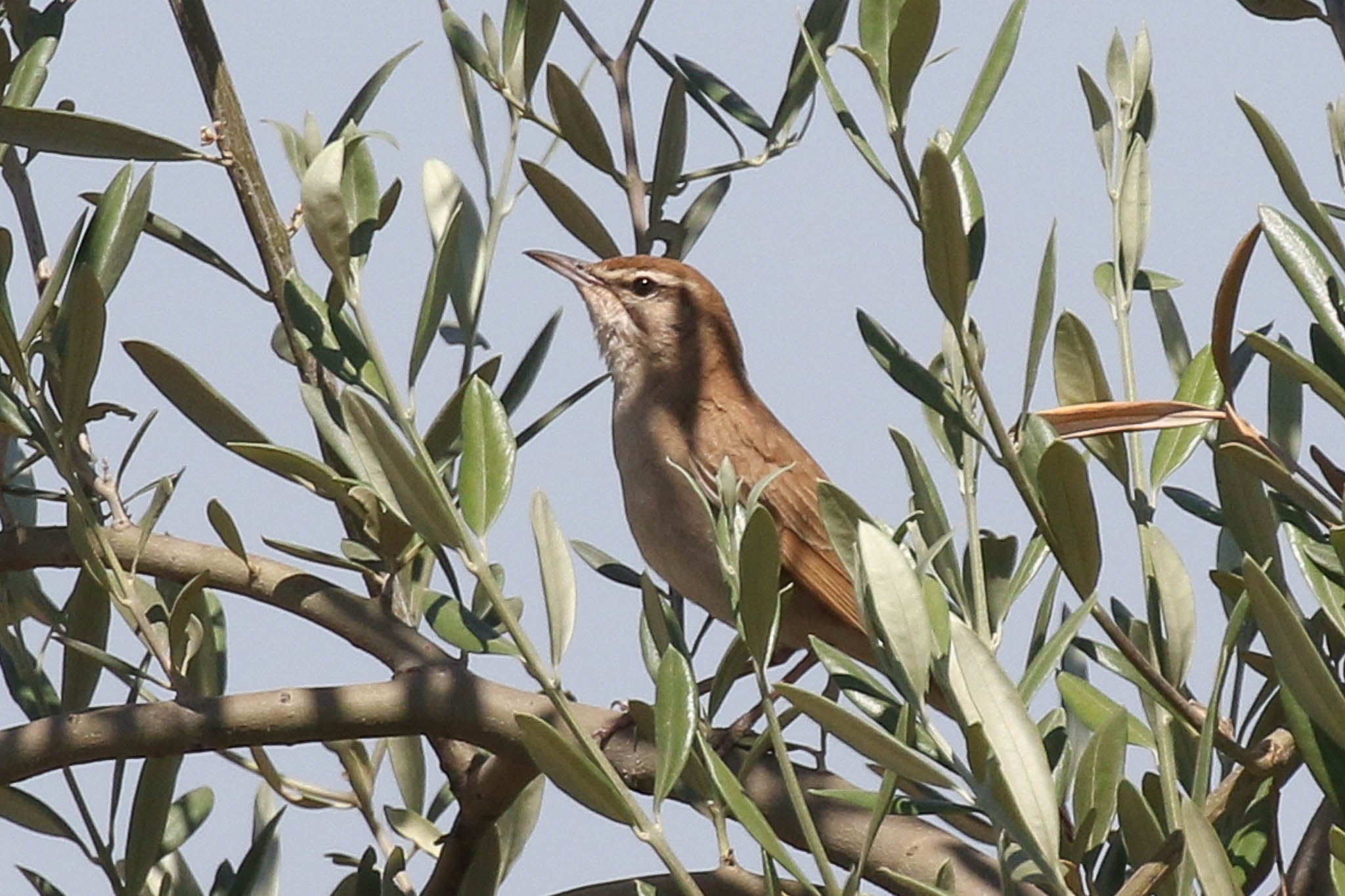
We drove on down into the Rio Guadiana valley next. We walked in through the trees and could hear Common Waxbills calling, eventually getting good views of them by the path. There were Alpine Swifts and hirundines hawking overhead, including our only Sand Martin of the trip, and Blackcaps and Cetti’s Warbler singing. A Great Spotted Woodpecker flew across the track in front of us. It was very dry here, so we tried a track the other side which wound down towards the river.
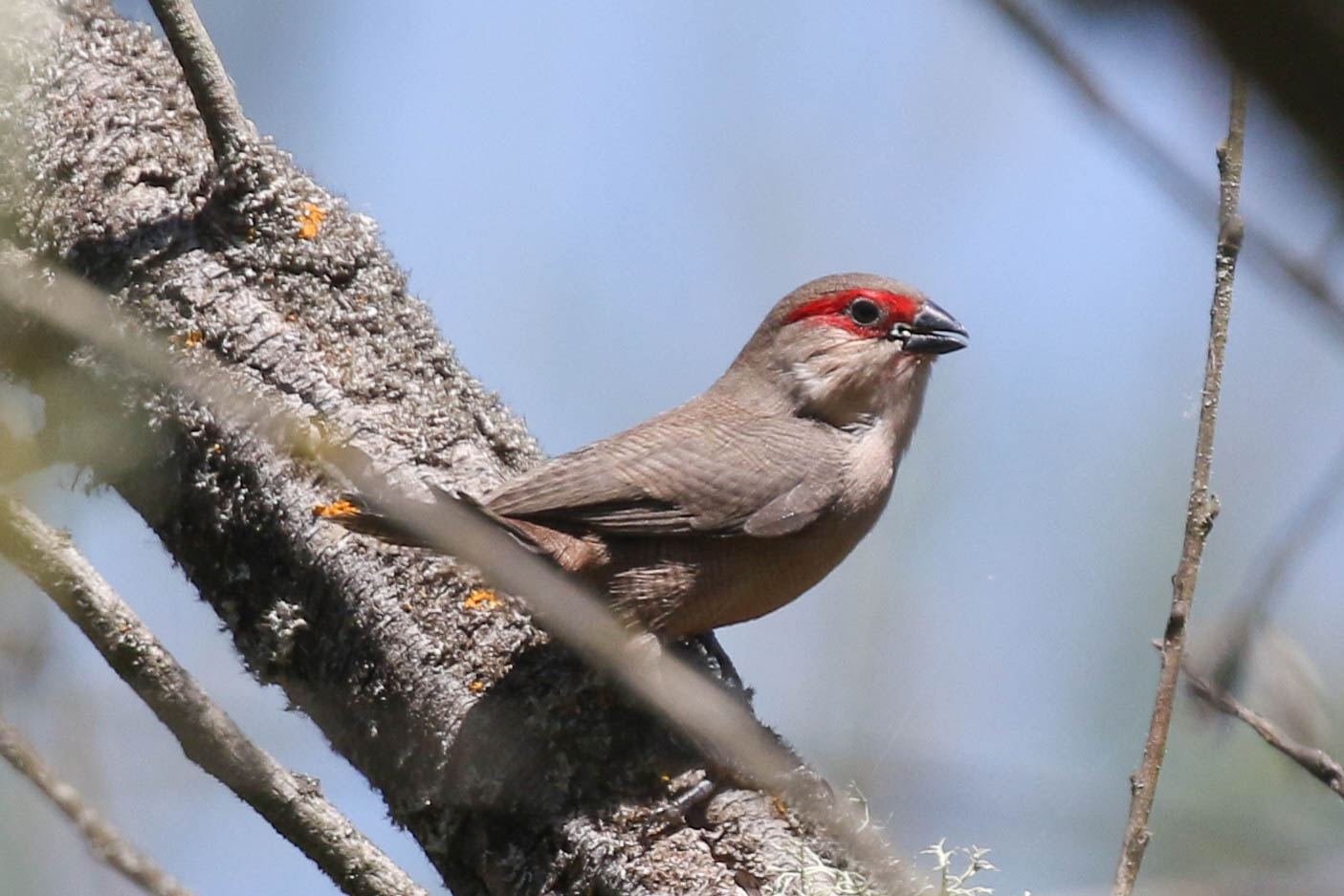
Our target here was Western Olivaceous Warbler and as we walked along now we heard one sing briefly. We looked across to see it flitting around in some ash trees, but it was very hard to pick up in all the leaves and the group couldn’t get onto it before it dropped down and disappeared. We tried going a little further, but just found a couple of Reed Warblers singing.
As we came out by the river three Glossy Ibis flew up from the edge and looking downstream, there were several Little Egrets and Spoonbills in the water and a Purple Heron which flew out of the reeds. A couple of Scarlet Darter dragonflies were down in the vegetation by the river and a Green-eyed Hawker flew back and forth overhead – nice additions to the trip insect list.
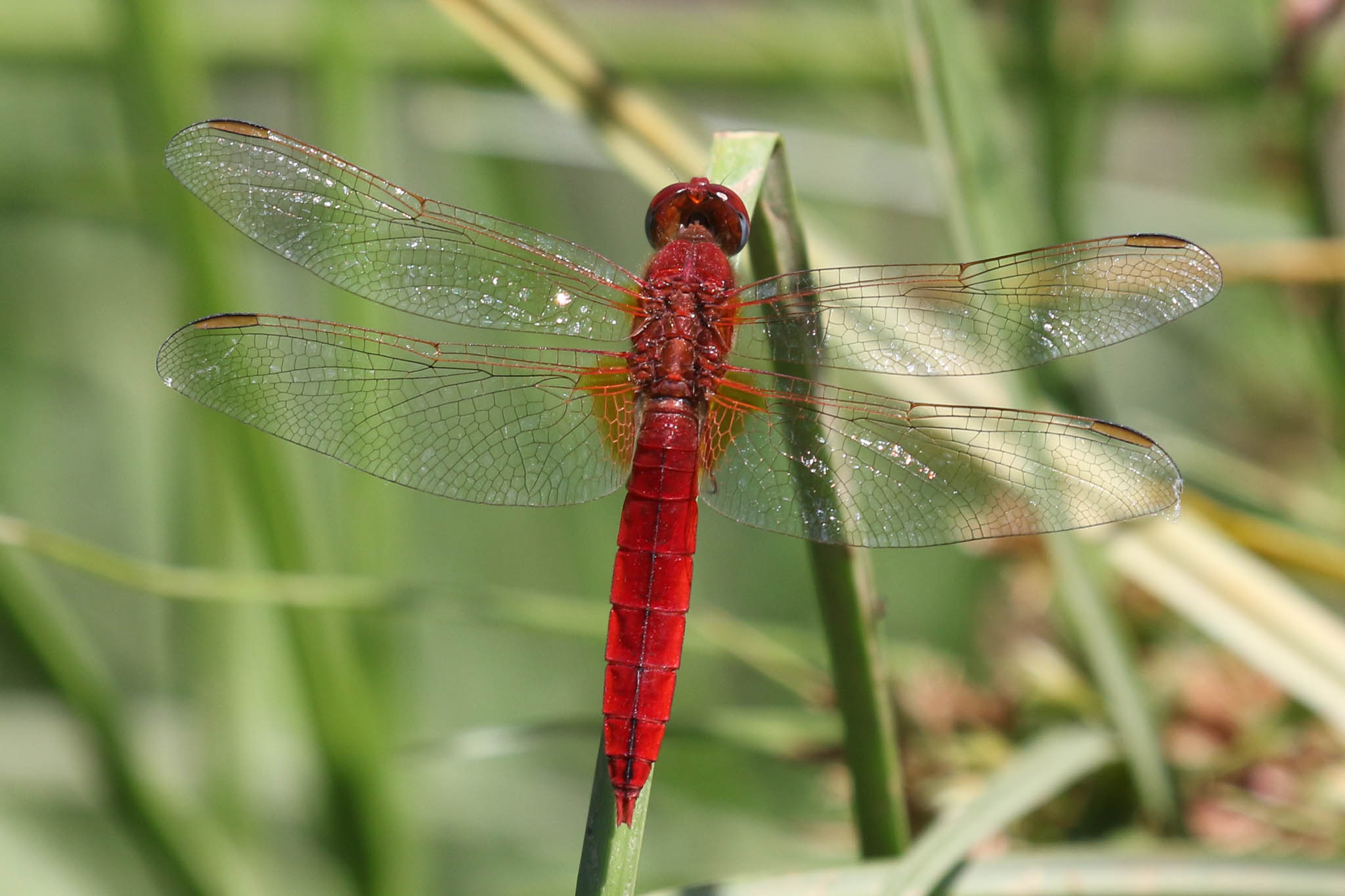
We were already late for lunch, so we set off to walk back thinking we would have to try again afterwards, but we could hear the Western Olivaceous Warbler singing again now. We walked round the back of the ash trees this time and eventually it came out of some tamarisks and flew across the track in front of us. It landed in some reeds briefly where we could all see it flicking around, before it flew back across and up into the ash trees again, singing. Success! Back to the minibus, it was not the most attractive area we have had for a lunch stop this week, but we found some welcome shade under the road bridge with the traffic rumbling overhead. When we got back in the minibus, it was showing 36C.
After lunch, we drove in to the city of Merida. We found somewhere to park and walked down through the park towards the river. There were one or two Golden Orioles fluting in the trees and one flew across ahead of us. Out on the Roman bridge, it was very hot in the sunshine. A couple of the group decided to stay back in the shade in the park and found a local bar, but the rest of us walked out over the bridge. There were lots of swifts zooming around low, stunning views of Alpine Swifts at eye level and Pallid Swifts and Common Swifts swooping in under the bridge below us.
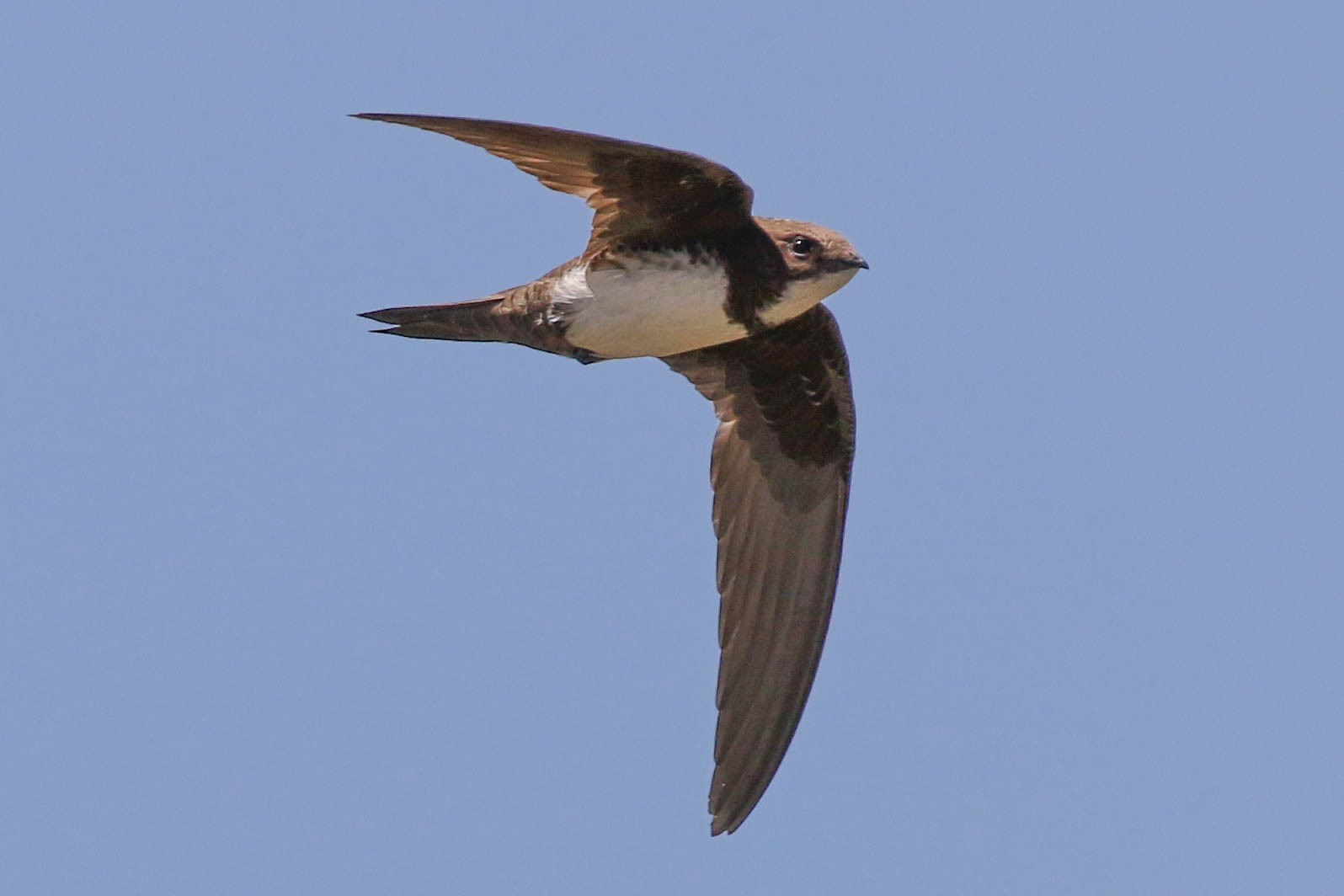
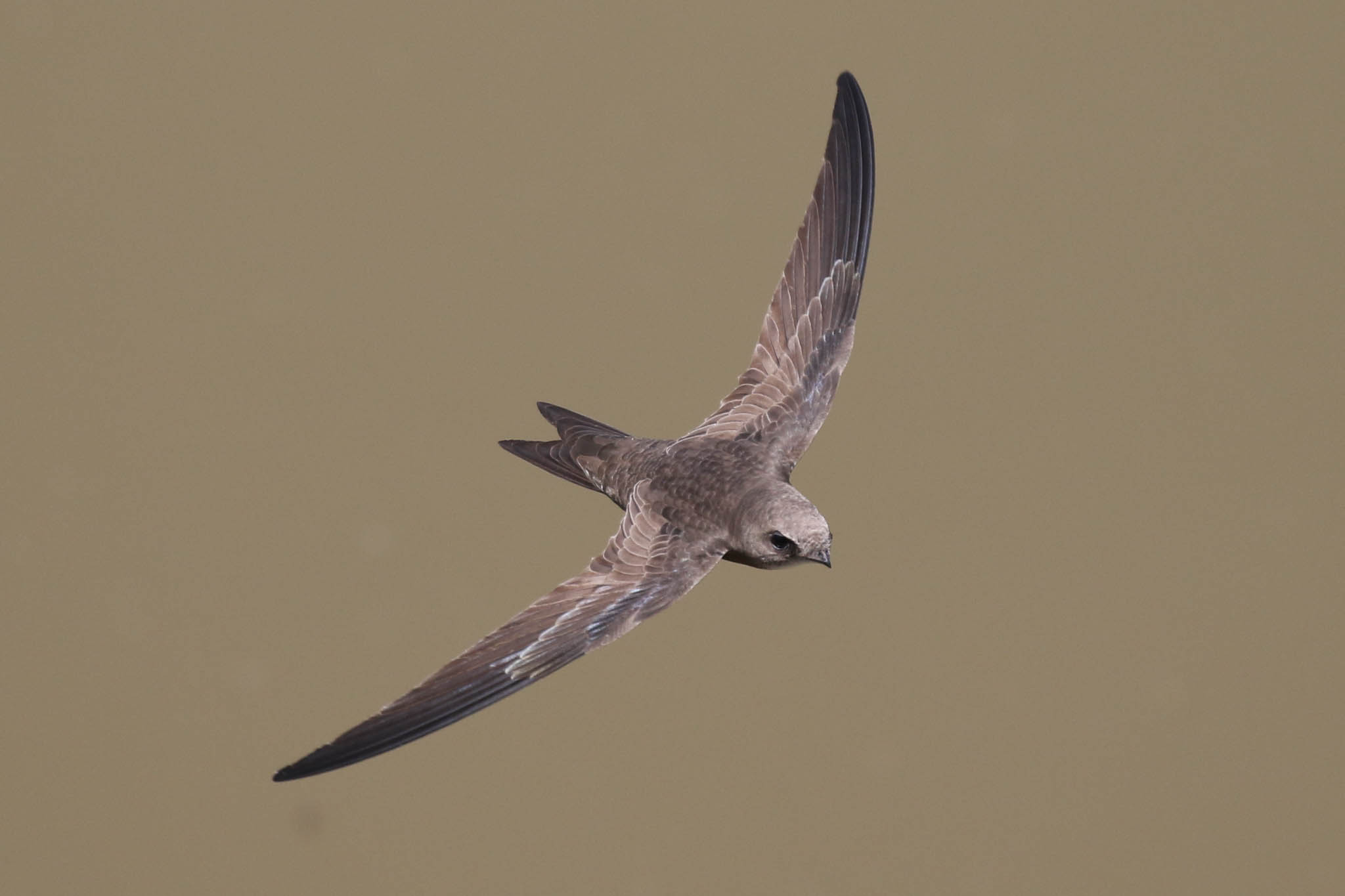
We could see lots of Cattle Egrets down on the stony islands on the river and heard a Penduline Tit calling from somewhere in the trees in the middle of one. On the far side, we found a family of Long-tailed Tits in the willows below the bridge.
We walked up through the park on the far side. As we stopped for a drink at one of the water fountains, another Golden Oriole flew out of the trees. Just beyond the Lusitania Bridge, there were lots of herons in the trees on the islands, lots of young Cattle Egrets and Glossy Ibis in the water. One of the group had a brief Squacco Heron. Two Night Herons flew out low over the water and round the far end of the islands, so we walked up and could see one in the water between the reeds, where we got a nice view through the scope before it flew again. A Grey Heron was perched right on the top of the trees, king of the castle!
As we walked back through the park, we heard another Penduline Tit calling from the riverbank, but it had gone quiet when we walked over to listen. An introduced Red-eared Slider terrapin seemed to be excavating a hole to lay its eggs in the grass. Walking back over the bridge, we stopped for more great views of all the swifts. Two Spoonbills circled over. We were almost back to the far end and stopped to scan the last clump of willows and finally found a Penduline Tit in the reeds below us.
It was a long drive back to Trujillo from here. We called in briefly at the bullring, but it was still very hot and quiet. There were lots of Spotless Starlings on the roof and a single Lesser Kestrel circled over. Then it was back to Pago for dinner. Afterwards, we had a late foray out to try for Red-necked Nightjar again. Armed with some information hot off the press, we headed out to an area where they had apparently been seen last night.
We parked in a layby out in the rocky countryside and walked up a small path onto the hillside opposite. It was an amazing sunset and as we watched, flocks of Spotless Starlings streamed in over the countryside, heading in to roost. Not long after sunset, we heard a Red-necked Nightjar call briefly in the distance and walked a little further up to where we could see over towards where the sound had seemed to come from. Scanning the hillside, we picked up a Red-necked Nightjar flying across in the distance but most of group couldn’t get onto it.
At least we were in the right place. We continued scanning and then spotted one flying straight towards us low over the broom. It flew out over an open grassy patch right in front of us and right past us just a few metres away, so close you didn’t even need binoculars! Mission accomplished, it was starting to get dark now, so we walked back down. We called in briefly in Madroñera on the way back, to see if we could hear any owls, but it was a little late now and all was quiet. It had been a long day and we were all very tired, so we headed back to bed.
Saturday 28th May
Unfortunately, it was time to head back to the airport today. After packing up and saying farewell to our hosts, we set off on the drive north to Madrid. We had time for a couple of stops on the way, so we turned off the motorway first at Jaraceijo and took a track out into an area of scrub. A large area has unfortunately been cleared here since our last visit, but some remains further down.
We parked at the end and got out and as we walked back along the track several Dartford Warblers flitted in and out of the bushes either side ahead of us. More Dartford Warblers were singing out in the middle and we didn’t have to go far before we heard a Spectacled Warbler singing too. They were not easy to see today, but we did eventually get nice views of a couple perched up in the tops of the broom. Our target here achieved, as we drove back to the main road, there were lots of butterflies around some scabious including a couple of Queen of Spain Fritillaries.

Further north, we only had time for a quick stop at Arrocampo now. There were already a few people by the first hide when we arrived, and fewer herons than we had seen the other day. We did have better views Little Bittern – first a female in the base of the sedges just across the water, which disappeared in before creeping back out onto the edge, then a couple of males, one which flew across and a second low down in the reeds.

Several of the group hadn’t seen the Purple Swamphen here the other day and we could just hear them calling from the rushes again at first. Eventually a young one appeared on the edge of one of the channels, before swimming across the water. A Golden Oriole flew in over the reeds and disappeared into a tree the other side of the hide. Then it was time to leave.
The journey back to Madrid was uneventful, but when we arrived at check-in at the airport we found our flight back to Gatwick was delayed. The staff would not even check us in at first, as they thought it might be cancelled – as the flight out from Gatwick (on which we were due to return) had already been. Thankfully, it turned out that an empty plane was being sent out to fly everyone back to London and the delay meant we had plenty of time to clear the unbelievably long queue to have our passports stamped at Spanish immigration. We eventually arrived back at Gatwick only three hours late – it could have been much worse! – and we said our goodbyes.
















